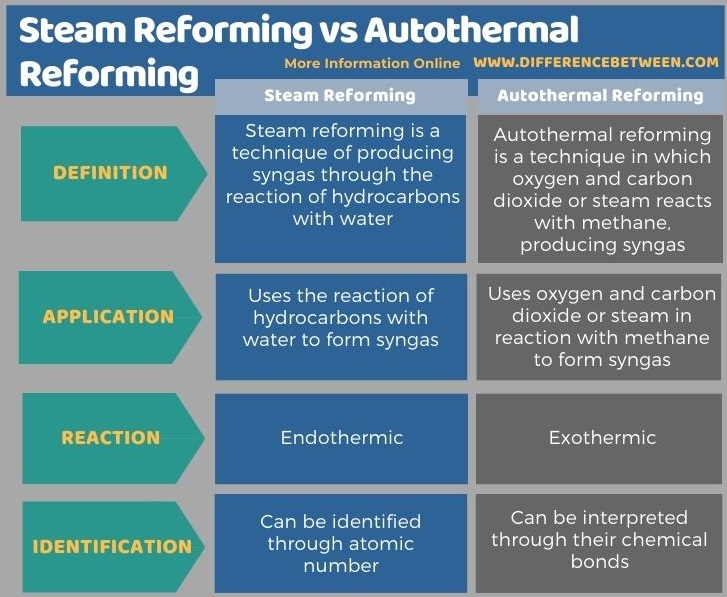Difference Between Steam Reforming and Autothermal Reforming
Table of Contents
The key difference between steam reforming and autothermal reforming is that steam reforming uses the reaction of hydrocarbons with water, whereas autothermal reforming uses the reaction of methane with oxygen and carbon dioxide or steam to form syngas.
Reformers are devices useful in chemical synthesis of pure hydrogen gas from methane in the presence of a catalyst. This device uses two main reactions: steam reforming, autothermal reforming or partial oxidation. There are many different reformers in industries, and autothermal reformer and steam methane reformer are the most common ones.
CONTENTS
1. Overview and Key Difference
2. What is Steam Reforming
3. What is Autothermal Reforming
4. Side by Side Comparison – Steam Reforming vs Autothermal Reforming in Tabular Form
5. Summary
What is Steam Reforming?
Steam reforming is the technique of producing syngas through the reaction of hydrocarbons with water. In this technique, the most common feedstock is natural gas. The purpose of this reforming reaction is the production of pure hydrogen gas. Syngas is a mixture of hydrogen gas and carbon dioxide gas. The reaction that is taking place in this reformer is as follows:
CH4 + H2O ⇌ CO + 3H2
The above reaction is highly endothermic; it consumes energy from the surrounding. The hydrogen gas produced through this reformer is named “grey hydrogen” when all the carbon dioxide gets released into the atmosphere. The product is named “blue hydrogen” when most of the carbon dioxide is captured and stored geologically.

Figure 01: Hydrogen Production via Steam Reforming Method
Majority of the world’s hydrogen gas is produced through steam reforming of natural gas. Hydrogen gas produced in this manner is useful in the industrial synthesis of ammonia and other chemicals. This reaction takes place in a reformer vessel having a high pressure mixture of steam. Here, methane is put into contact with steam in the presence of a nickel catalyst. When choosing the correct catalyst, it is important to use a catalyst having a high surface area to volume ratio because of the diffusion limitations that occur at high operating temperatures. The most common catalyst shapes we can use include spoked wheels, gear wheels, and rings having holes. Moreover, these shapes consist of a low pressure drop that is important for this application.
What is Autothermal Reforming?
Autothermal reforming is a technique in which oxygen and carbon dioxide or steam reacts with methane, producing syngas. This reaction occurs in a single chamber where methane gets partially oxidized. The reaction in this device is exothermic because oxidation occurs here. We can denote the term autothermal reforming as ATR. Generally, when the reaction mixture contains carbon dioxide, we can indicate the product ratio of hydrogen gas: carbon monoxide as 1: 1. But if we are using steam instead of carbon dioxide, then product mixture would be in the ratio of hydrogen gas: carbon monoxide as 2.5: 1. Reactions that are taking place in the reformer are as follows:
Using carbon dioxide:
2CH4 + O2 + CO2 ⟶ 3H2 + 3CO + H2O
Using steam;
4CH4 + O2 + 2H2O ⟶ 10H2 + 4CO
What is the Difference Between Steam Reforming and Autothermal Reforming?
There are many different reformers in industries where autothermal reformer and steam methane reformer are the most common ones. The key difference between steam reforming and autothermal reforming is that steam reforming uses the reaction of hydrocarbons with water, whereas autothermal reforming uses oxygen and carbon dioxide or steam in reaction with methane to form syngas. Moreover, steam reforming is an endothermic reaction while autothermal reforming is an exothermic reaction.
Below infographic summarizes the differences between steam reforming and autothermal reforming in tabular form.

Summary – Steam Reforming vs Autothermal Reforming
Reformers are devices useful in chemical synthesis of pure hydrogen gas from methane in the presence of a catalyst. There are two types of devices as the steam reformer and autothermal reformer. The key difference between steam reforming and autothermal reforming is that steam reforming uses the reaction of hydrocarbons with water, whereas autothermal reforming uses oxygen and carbon dioxide or steam in reaction with methane to form syngas.
Reference:
1. “Autothermal Reforming.” ScienceDirect Topics, Available here.
Image Courtesy:
1. “Hydrogen production via Steam Methane Reforming graphic”
ncG1vNJzZmivp6x7pbXFn5yrnZ6YsqOx07CcnqZemLyue8OinZ%2Bdopq7pLGMm5ytr5Wau26%2F056YpmWimrOwvsyipaBlkaOxbq3UraatoJWnuqK4jKucn6eioravs44%3D